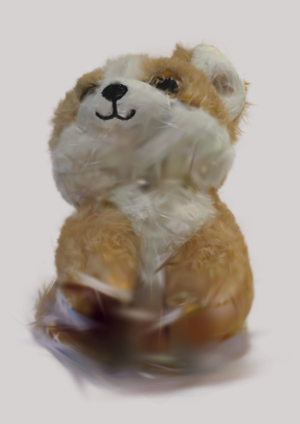Practical Tips, Timing, and FAQ
Practical tips for better results
The following suggestions can help improve reconstruction quality and workflow efficiency:
- Capture more images when possible. Larger datasets improve reconstruction robustness, even if they require more cleanup or processing time.
- Experiment with tool parameters. Adjusting settings in COLMAP and gsplat can significantly affect results.
- Document parameter choices. Keeping track of parameters helps ensure reproducibility and improves future runs.
- Use image downsampling for faster training. Use higher
--data_factorvalues (for example, 4) during testing to reduce memory and speed up training. For best quality, train final models on high-resolution inputs.
Notes on the example dataset
This tutorial’s dataset was captured mostly from dome-like camera angles, covering only the upper hemisphere of the object. As a result, the bottom of the model appears incomplete when viewed from below.

Model view from below, showing sparse Gaussians and an incomplete surface.
For many use cases, such as turntable demos or frontal visualizations, this coverage is sufficient.
However, for fully enclosed 3D models, you should capture additional images from lower angles.
If the object is rigid, consider placing it on its side to photograph the underside. Make sure there is sufficient overlap with other views to maintain alignment.
Approximate time per stage
The table below summarizes typical time requirements for each stage in the pipeline:
| Step | Approximate Time |
|---|---|
| Capturing images | 20 minutes |
| Processing images in COLMAP | 1 minute |
| Training a model in gsplat | 12 minutes |
| Editing in SuperSplat | 10 minutes |
Note: COLMAP time reflects only a successful reconstruction run. Parameter tuning and retries can add significant time depending on the dataset.
Frequently asked questions
Note: These answers apply primarily to object- or tabletop-scale capture, as demonstrated in this tutorial. Outdoor scenes or large-scale environments may require different tools, workflows, and parameter settings.
Can I use a smartphone camera?
Yes. While this tutorial used an interchangeable-lens camera, modern smartphones can produce similar results if lighting is adequate and images are sharp and stable.
Should I take photos or record video?
Photos are preferred due to better control over focus and exposure. Video can work if shot at 60 FPS or higher with minimal blur.
How many images do I need?
For small objects, 100–250 images is usually enough. Full 360° coverage may require more.
Can I use zoom, autofocus, or auto exposure?
Try to avoid them. Use manual focus and a fixed focal length to maintain consistent camera intrinsics for more accurate pose estimation.
Do I need to capture all sides of the object?
Not always. For turntable-style outputs, upper and side coverage may be enough. For full 360° models, also capture the underside.
Does the object need to have texture?
Yes, ideally. Surfaces with visible patterns, edges, or textures improve feature matching. Flat, shiny, or textureless objects are harder to reconstruct.
Can I use a textured background to help?
Yes, but keep in mind:
- COLMAP may rely on the background for pose estimation
- Reconstruction quality on the object itself may still be limited
- You may need extra cleanup to isolate the object afterward
Also see COLMAP’s FAQ on weakly textured surfaces.
© 2025 SmartDataScan.
This section is licensed under a Creative Commons Attribution-NonCommercial-ShareAlike 4.0 International License.